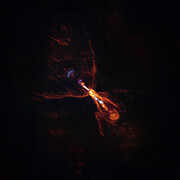
Astronomers Capture the Birth of a Solar System for the First Time
Hey everyone, have you ever wondered what the birth of a solar system actually looks like? Well, for the very first time, astronomers have caught it in action — and it’s absolutely incredible. Using the immense power of two of the world’s most advanced observatories — the ALMA telescope in Chile and NASA’s James Webb Space Telescope — researchers have managed to observe the very moment planets start to form around a distant star. This is like seeing a baby picture of our own Solar System.
The star at the center of this discovery is called HOPS-315, located about 1300 light-years from Earth. It's a so-called "protostar," basically a baby star still surrounded by a dense cloud of gas and dust. Around it is a protoplanetary disc — the raw material for building planets. And here's the magic: scientists found evidence of the very first solids — hot minerals — beginning to condense from gas within that disc. That’s the spark that kicks off planet formation.
What’s truly fascinating is that these minerals are made of silicon monoxide (SiO), the same type of material found in ancient meteorites from our Solar System. This not only connects the new system to our own origins, but it allows us to peer back in time. Think of it this way: what we’re seeing around HOPS-315 is what likely happened around our Sun over 4.5 billion years ago, just before Earth and the other planets came into being.
Also Read:- Argos and Alouettes Clash in High-Stakes Week 7 Showdown
- England Edge Sweden in Emotional Euro 2025 Shootout Thriller
Melissa McClure, who led the study from Leiden University, called it the first time we’ve captured the exact moment when planet formation begins around a star other than our Sun. And Merel van 't Hoff, another co-author, described it as looking at a photograph of the Solar System in its infancy. Together with other researchers from the U.S., Europe, and Asia, they used infrared and radio observations to locate the SiO signatures both in gas and solid form — clear signs that the minerals are just starting to crystallize.
Even more exciting is that these minerals were detected in the same kind of orbit where our own asteroid belt lies — between Mars and Jupiter. So not only is this an early solar system, it's unfolding in a way that's strikingly similar to our own.
This discovery doesn’t just answer one of the big questions in astronomy — how planets begin — it opens up entirely new ways to study the history of our cosmos. It shows that the combination of ALMA’s high-resolution imaging and JWST’s powerful infrared vision is changing how we understand the universe.
Honestly, this isn’t just a win for science. It’s a poetic moment. We’re literally watching the seeds of a new world take shape — perhaps even the future home of life, billions of years from now. And the best part? It all started with a few specks of dust, slowly coming together under a newborn star's warm glow.
The stars keep whispering stories. We just got a little better at listening.
Read More:



0 Comments